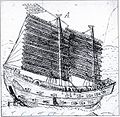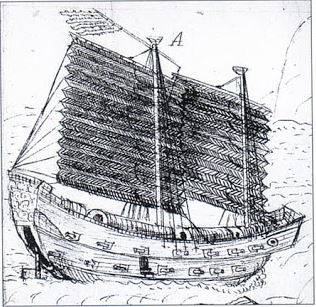English: A Ming junk 1637, by Peter Mundy. While it showed 2 gun decks and many gun ports, the gun consisted of
drake or
minion drake, a cannon of a small bore, typically 3-inch (76.2mm), and fired a 5-pound cannonball. Transcript from the book:
A : The Forme of the Admirall Juncke [1][2] thatt came unto us as wee wente towards Cantan. They have no topsailes, only Mainsaile and Foresaile of Cajanes [3] and Bambooes, made like Mattes, which instead of taking in, they lett Falle in plates one uppon another as lettre B. This had 2 things on their heads of their Mast, somwhatt like toppes ; others had butt one, and Most of them None. The better sort had Falce galleries, all of them Doores in their broadsides. Furnished with Drakes, such smalle gunnes as wee tooke outt of the Castle. They saile very swifft and will lye Nearer the winde then wee can, turne and tacke sodainely, their sailes (whither afore or abaft the Mast) all one like hoyesailes [4], high sided, hard to enter, there beeing Nothin to hold by, weakly plancked and timbred and about [blank] tonnes burthen the bigger sort. These are the Kings Men of Warre hereaboutts in this River and Creeks adjoyning.
Notes:
[1] The term junk (Malay
ajong,
jong, a large ship) is applied by Europeans to Chinese vessels of all sorts. The generic Cantonese word for a ship, boat or junk is
shun.
[2] Cantonese,
shui-sz-shun, Admiral's ship. Cf. Father Magaillans, History of China, p. 129: "Among the King's Barks, those which are call'd So
chuen are employ'd to carry the Mandarins to their several Governments. These are made like our Caravels, but high, and so well Painted . . . that they resemble Buildings erected for some publick Solemnity, rather than ordinary Hoy's."
[3]
Cajan (
cadjan) is a term used for two entirely different things, (I) Malay
kajang, any palm-leaf, especially for thatching and matting, usually nipa (
nipa fruticans), toddy palm (tur, palmyra) and the coconut palm. (II) Malay
kachang, any pulse or leguminous plant, usually in India dal (
Cajanus Indicus)
[4] That is, square sails in one piece. The hoy was a small vessel, usually rigged as a sloop, but Mundy is describing the ordinary square sail of Oriental river boats.
[1] 
